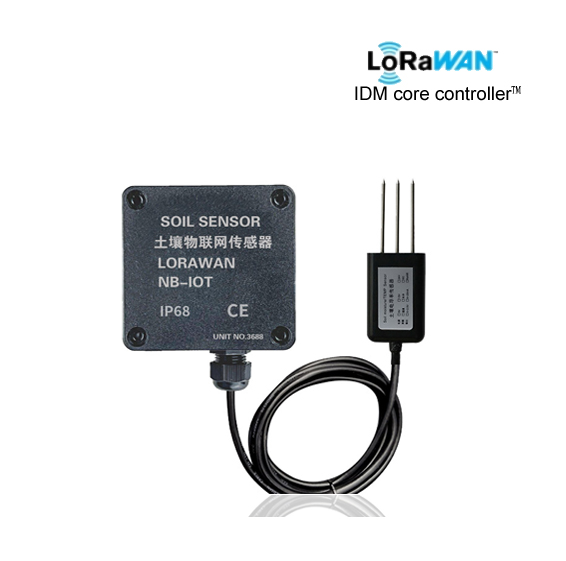The principle of wireless soil moisture sensor is mainly based on the frequency domain reflectometry (FDR) principle, which uses the principle of electromagnetic waves to measure the dielectric constant of the soil, thereby inferring the moisture content of the soil. This sensor uses the electromagnetic wave propagation in the soil to measure the apparent dielectric constant (ε) of the soil, and then obtains the soil volume water content (θv).
The wireless soil moisture sensor adopts the FDR principle, has good sealing, can be directly buried in the soil for use, is not affected by corrosion, has high measurement accuracy and reliability, ensures normal operation, fast response speed, and high data transmission efficiency. In addition, the wireless soil moisture sensor also uses other technologies, such as time domain reflectometry (TDR) technology, which reflects the moisture content of the soil by measuring the impedance change of electromagnetic waves in the transmission path. These technologies together ensure that the wireless soil moisture sensor can provide real-time and accurate soil moisture data, which is of great significance for optimizing irrigation management, increasing crop yields, protecting natural resources, and predicting natural disasters.
LORA wireless soil moisture sensor IDM-RD10 is an economical soil moisture sensor developed by the company through sensors and LoRa modules. The LORA wireless soil moisture sensor can be buried in the soil for a long time, is resistant to long-term electrolysis, corrosion, vacuum potting , and is completely waterproof. It is suitable for various soil types and is widely used in the Internet of Things industry applications for soil moisture collection in agriculture, fields, hydrology, geology and other industries.
Power supply
Battery powered, voltage 3.6VDC
Detecting soil temperature
-20℃~70℃
Detecting soil moisture
0-100%RH
Monitoring sudden conductivity
0-10000uS/cm
Detection of soil temperature accuracy
±1℃
Detect soil moisture accuracy
±5%
Detecting soil conductivity accuracy
±5% F.S
communication method
LORAWAN wireless communication
RF operating frequency band
470-510MHz
stand-by current
80 uA
Operating temperature
-20℃~70℃
Installation
Pole installation
Protection level
IP68
Product Size
131mm*74mm*50mm
Measurement method
1. Quick measurement method
Select a suitable measurement location, avoid stones, ensure that the steel needle does not touch hard objects, discard the topsoil according to the required measurement depth, maintain the original tightness of the soil below, hold the sensor firmly and insert it vertically into the soil. Do not shake it left and right when inserting. It is recommended to measure multiple times within a small range of a measurement point to obtain the average value.
2. Buried measurement method
Vertically dig a pit with a diameter of >20cm, insert the sensor needle horizontally into the pit wall at a predetermined depth, fill the pit tightly, and after a period of stability, you can perform continuous measurements and records for days, months or even longer.
· Precautions for use
1. The steel needle of the sensor is fully inserted into the soil to be tested. Do not shake the sensor during insertion to prevent affecting the sensor probe;
2. The sensor can be used for multi-layer observation and to establish a soil moisture monitoring station;
3. If you feel there is something hard in the soil, please reselect the test point to avoid damaging the sensor probe;
4. Do not insert the probe into a hard soil block to avoid damaging the probe; when measuring, the density of the soil to be measured should be as uniform as possible;
5. When removing the sensor from the soil, do not pull the cable directly; after use, clean and dry the probe to keep it clean;
6. If the measurement point is not selected properly, it may lead to unpredictable measurement errors (>10%vol). Rough installation will cause the stainless steel needle of the sensor to be damaged, affecting the measurement accuracy. The following aspects must be paid attention to during installation: (1) Abnormal holes or pores. If there are holes or pores within the sensing range of the sensor, it will cause measurement errors. Especially when plugging and unplugging the sensor, repeated operations at the same position must be avoided; (2) Installation angle. In different applications, the sensor can be installed in different ways. There are two commonly used methods, horizontal installation and vertical installation. The distribution of moisture in the soil medium is affected by many factors such as space and time. The reasonable installation method of the sensor must eliminate these effects to the greatest extent. When installed vertically, the sensor measures the average moisture content of the sensing interval of nearly 6 cm long; (3) Sampling point. The selection of sampling points must be carefully considered. In addition to the two points mentioned above, there are many other factors that affect the measurement accuracy of the sensor, which can be listed as: changes in soil density and composition, gravel, plant roots, earthworm loosening effect, soil drainage status, moisture volatilization in the soil surface, etc.








